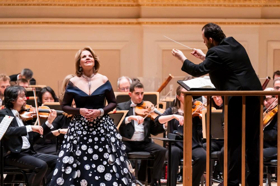Review: What Retirement? Fleming Soars in Final Scene from CAPRICCIO with the Boston Symphony under Nelsons

Boston Symphony. Photo: Chris Lee
Since my days as a pothead are long gone (LOL)--did anyone ever watch 2001: A SPACE ODYSSEY without a little help from a friend?--I came to the Boston Symphony's (BSO) concert at Carnegie Hall the other night more interested in hearing the excerpts from Richard Strauss's CAPRICCIO, including Renee Fleming in its final scene, than in the composer's ALSO SPRACH ZARATHUSTRA. As it turned out, both parts of the concert, under Music Director Andris Nelsons, had much to recommend.
CAPRICCIO is Strauss's "opera about opera": Which is more important, the words or the music? Here, the heroine must decide between two loves, a poet and composer. (Nudge, nudge.) The two suitors offer presents for her birthday: a sonnet from one, a string sextet from the other. The concert had started off with the piece of chamber music, which Strauss wrote as a kind of overture to the opera. (The sonnet, which comes later and was not on the BSO program, was written not by librettist Clemens Krauss, but by poet Pierre de Ronsard.)
At Carnegie, it was performed by members of the orchestra, violins Tamara Smirnova and Haldan Martinson, violas Steven Ansell and Cathy Basrak and cellos Blaise Dejardin and Adam Esbensen. They gave a sensitive rendering of the chamber piece, though I still prefer music of this intimacy performed in a smaller hall. (In fact, it had been given its Carnegie premiere in 1976 by the Orpheus Chamber Ensemble in the Recital Hall [then Carnegie now Weill], which is a fraction of the main auditorium's size.)
At its conclusion, the rest of the orchestra piled on stage, filling it to the rim: One advantage of being on the same program as ZARATHUSTRA is that the tone poem is scored for a "large orchestra"--the kind most associated with Strauss's music though seldom (if ever) for CAPRICCIO. Before getting down to the vocal entry from the score, the orchestra took on the elegant "Moonlight Music" ("Mondscheinmusik") from the opera in a luxurious performance.
I admit to having something of a love-hate relationship with the soprano, who can be a little too placid at times for my taste, but she was certainly in the "zone" as Countess Madeleine, sounding as glamorous as she looked in the lushly scored piece.
And she had no problem soaring over the pumped-up ensemble without losing any of her purity of tone or her immediacy with the audience, which clearly adored her. She seemed very much in tune with the inner conflicts of her character about which of her loves she preferred (though it remains unspoken, if not unclear, in the opera) and presented her dilemma as if it were a lieder concert.
From Strauss, the program turned to the soprano's encore by Andre Previn, the recently deceased composer-conductor, who was not only associated with the orchestra but whose operatic treatment of Tennessee Williams's A STREETCAR NAMED DESIRE was written for Fleming. Here, my reservations about the singer returned: While she sounded gorgeous and appeared radiant in "Sea Air," the opera's conclusion, this was no Blanche DuBois from Williams's play.
She was more like the dreamy twin sister of Countess Madeleine. With her flowing gown (looking Aubrey Beardsley's peacock dress illustration for Wilde's SALOME) and diamonds galore, she seemed far from the woman on the verge of a nervous breakdown, about to be carted off to the asylum. And this was not simply because she was singing the aria in concert; I recall my similar reaction to the full performance of the opera. I couldn't tell then whether it was the reluctance of the singer to cut loose or the composer to provide the mad scene as it could have been; now, it seems a combination of the two.
The BSO has a special relationship with ZARATHUSTRA, having given its Carnegie Hall debut almost 120 years ago to the day, March 22, 1900, under Wilhelm Gericke, just a few months before the death of Friedrich Nietsche, who wrote the novel of the same name that had such themes as the death of God and the super-man. While Strauss was criticized for not taking on some of Nietsche's theme more directly (or blatantly), one can't help but admire the sweep and flare shone in the performance of the tone poem, which could be bombastic one moment and lush the next, then back again.
Nelsons and the BSO gave it a bold reading in general, filled with details that are the conductor's trademark approach that left one's head spinning. with pumping chords and undiluted power (especially in "The Convalescent" section) here and refinement there. The prominent violin solo in "The Dance Song" ("Das Tanzlied"), in a gorgeous execution by Associate Concertmaster Tamara Smirnova, runs the gamut from graceful waltz to bombastic climax, with the 12 tolls of a great bell.
Did Strauss purposely want to confound audience with the very end of the work, "The Night Wanderer's Song" ("Nachtwanderlied")? Perhaps, with its unresolved shift in keys in sharp contrast to the piece's opening in a primeval sunrise that has come to epitomize the conductor's work for mass audiences since the opening of the 2001 film in 1968.
Reader Reviews
Videos

